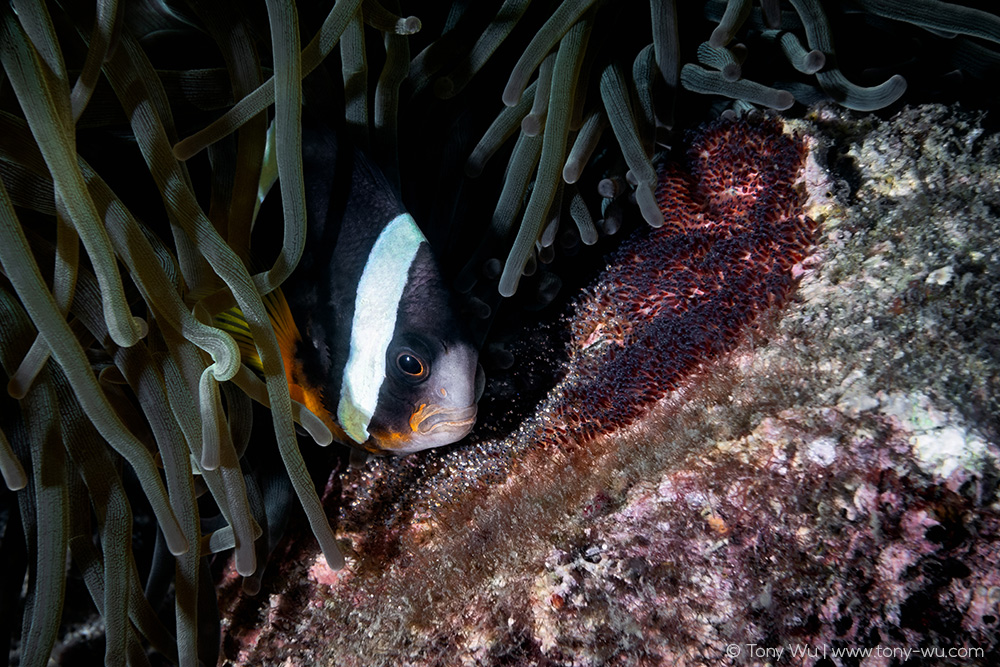This is an Amphiprion clarkii anemonefish tending to developing eggs.

It is probably male, as males of this species tend to be the ones to care for embryos.
A scene that is nothing out of the ordinary for scuba divers in much of the world's warm waters, right?
Maybe not.
Take a closer look, and you'll see two sets of eggs, each at a distinct stage of development.
The eggs close to the adult look silvery metallic because they are nearly mature, almost ready for lift-off. The ones higher up on the rock are a muddy maroon, indicating that they need more prep before launch.
I don't often pay attention to anemonefishes, but this situation caught my eye.
The way things usually work, spawning and rearing take place sequentially. One clutch of eggs is deposited, fertilised and raised to maturity, followed by another bunch of eggs and so on.
This scene suggests that spawning of a second set of eggs took place while the first was still on the assembly line.
Hmmmm.
A bit of thought, research, and discussion with similarly piscine-obsessed, prone-to-going-down-mental-rabbit-hole friends provided some clues as to how this may have come about.
During breeding season, mature Amphiprion clarkii anemonefishes are most often found as male-female pairs, with non-breeding individuals sometimes present as well. This species, like (all?) other Amphiprion anemonefish are protandrous hermaphrodites (I believe this is the first time I've managed to spell that phrase without looking it up)—meaning that they begin life as males and later change to females.
Not all individuals make the change however. A study in Japanese waters(1) identified three life trajectories for individuals of this species: (a) sub-adult male to sub-adult female to adult female; (b) sub-adult male to adult male to adult female, (c) sub-adult male to adult male, no further change.
Another study in Japan(2) noted that three-way reproductive groupings are known to occur, often with the third wheel coming from a nearby male-female pair when something happens to one of the individuals in that pair.
Finally, there appears to be infidelity on the part of both males and females, meaning that spawning with individuals outside of the male-female pair structure happens with reasonable frequency.
Put all of this together, and one can imagine a number of possible situations.
If something happened to the female that deposited the almost-mature eggs here, maybe a sub-adult fish already at this site became an adult female and spawned prior to the original eggs hatching?
Perhaps something happened to the original female here and another mature female came from a different site to take her place?
Perhaps a male interloper arrived at this location and spawned with the female then left, thus producing a second batch of eggs?
Perhaps a female interloper arrived at this location and spawned with the male?
Or perhaps a full-grown male arrived just when something happened to the original female, then switched to female in order to spawn?
There are undoubtedly other potential scenarios. Short of taking DNA samples and figuring out which adult spawned which eggs, it is pretty much impossible to figure out what took place.
The point I wish to convey is that really interesting, head-scratching things are sometimes hidden in plain sight.
_______________________________________________________
(1) Hattori, A., Yanagisawa, Y. Life-history pathways in relation to gonadal sex differentiation in the anemonefish, Amphiprion clarkii, in temperate waters of Japan. Environ Biol Fish 31, 139–155 (1991). https://doi.org/10.1007/BF00001015
(2) Ochi, H. Mating behavior and sex change of the anemonefish, Amphiprion clarkii, in the temperate waters of southern Japan. Environ Biol Fish 26, 257–275 (1989). https://doi.org/10.1007/BF00002463